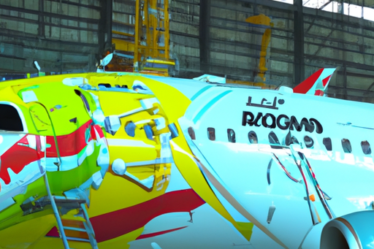
Challenges and Opportunities of the Projected Quadrupling of Intra-African Passenger Traffic
Africa is a continent of immense potential, and one area where this potential is set to be realized is in the aviation industry. According to recent projections, intra-African passenger traffic is expected to quadruple in the next 20 years. This presents both challenges and opportunities for the continent.
One of the main challenges that will arise from this projected increase in passenger traffic is the need for infrastructure development. Currently, many African airports are struggling to cope with the existing demand, let alone the expected surge in traffic. This means that significant investments will need to be made in expanding and upgrading airport facilities across the continent.
However, this challenge also presents an opportunity for African governments and private investors to collaborate and create world-class airports that can serve as hubs for international travel. By investing in infrastructure, African countries can position themselves as key players in the global aviation industry and attract more tourists and business travelers to the continent.
Another challenge that will need to be addressed is the shortage of skilled aviation professionals. As passenger traffic increases, so too will the demand for pilots, air traffic controllers, and other aviation personnel. African countries will need to invest in training programs and educational institutions to ensure that there is a sufficient supply of skilled professionals to meet this demand.
At the same time, this projected increase in passenger traffic also presents an opportunity for job creation. The aviation industry is a significant employer, and the growth in intra-African travel will create new jobs not only in airports but also in related industries such as tourism and hospitality. This can help to boost economic growth and reduce unemployment rates across the continent.
One of the key challenges that will need to be addressed is the issue of safety and security. As passenger traffic increases, it becomes even more crucial to ensure that safety standards are upheld and that security measures are in place to protect travelers. African countries will need to work together to establish and enforce robust safety and security regulations to instill confidence in travelers and attract more airlines to operate within the continent.
However, this challenge also presents an opportunity for African countries to collaborate and share best practices in safety and security. By working together, they can learn from each other’s experiences and develop a comprehensive framework that ensures the highest standards of safety and security across the continent.
Lastly, the projected quadrupling of intra-African passenger traffic also highlights the need for improved connectivity within the continent. Currently, air travel between African countries is often inefficient and expensive, with limited direct flights and long layovers. This hampers economic integration and makes it difficult for businesses to operate across borders.
To address this challenge, African countries will need to invest in improving air connectivity by increasing the number of direct flights and reducing travel times. This will require collaboration between governments, airlines, and other stakeholders to develop new routes and expand existing ones.
In conclusion, the projected quadrupling of intra-African passenger traffic in the next 20 years presents both challenges and opportunities for the continent. While there are significant hurdles to overcome, such as infrastructure development, skills shortages, and safety concerns, there is also the potential for job creation, economic growth, and improved connectivity. By addressing these challenges and seizing the opportunities, Africa can position itself as a key player in the global aviation industry and unlock its full potential.
Infrastructure Development for the Future of Intra-African Passenger Traffic

Africa is a continent that is experiencing rapid growth and development in various sectors, including transportation. In particular, the intra-African passenger traffic is projected to quadruple in the next 20 years. This growth presents both opportunities and challenges for the continent, and it is crucial to invest in infrastructure development to ensure a smooth and efficient transportation system.
One of the key factors driving the projected increase in intra-African passenger traffic is the continent’s growing population. With a population of over 1.3 billion people, Africa is home to a large and expanding middle class. As more people have the means to travel, there will be a greater demand for air travel within the continent.
To meet this demand, it is essential to invest in the expansion and modernization of airports across Africa. Many airports in the region are currently operating at or near capacity, leading to congestion and delays. By upgrading existing airports and building new ones, the continent can accommodate the projected increase in passenger traffic and provide a better travel experience for its citizens.
In addition to airport infrastructure, it is also important to invest in the development of a robust and efficient air traffic management system. This system includes air traffic control, communication, navigation, and surveillance technologies. By improving these systems, Africa can enhance safety, reduce flight delays, and increase the capacity of its airspace.
Furthermore, investing in the development of regional and national airlines is crucial for the growth of intra-African passenger traffic. Currently, many African countries rely on international airlines for their air travel needs. By establishing and supporting local airlines, African countries can promote connectivity within the continent and reduce reliance on foreign carriers.
To encourage investment in infrastructure development, African governments should create a favorable business environment and provide incentives for private sector participation. Public-private partnerships can play a significant role in financing and implementing infrastructure projects. By leveraging private sector expertise and resources, African countries can accelerate the development of their transportation infrastructure.
Another important aspect of infrastructure development for intra-African passenger traffic is the improvement of road and rail networks. While air travel is essential for long-distance travel, road and rail transportation are crucial for connecting cities and regions within a country. By investing in road and rail infrastructure, African countries can enhance connectivity and facilitate the movement of people and goods.
Moreover, the development of high-speed rail networks can revolutionize intra-African travel. High-speed trains can provide a fast, efficient, and environmentally friendly mode of transportation between major cities. By connecting cities across the continent, high-speed rail can promote tourism, trade, and economic development.
In conclusion, the projected quadrupling of intra-African passenger traffic in the next 20 years presents both opportunities and challenges for the continent. To ensure a smooth and efficient transportation system, it is crucial to invest in infrastructure development. This includes expanding and modernizing airports, improving air traffic management systems, supporting local airlines, and enhancing road and rail networks. By investing in these areas, African countries can promote connectivity, facilitate economic growth, and provide a better travel experience for their citizens.
Economic Implications of the Projected Quadrupling of Intra-African Passenger Traffic
The projected quadrupling of intra-African passenger traffic in the next 20 years is set to have significant economic implications for the continent. As more and more Africans take to the skies to travel within their own continent, there will be a surge in demand for air travel, leading to increased investment in airports, airlines, and related infrastructure.
One of the key economic implications of this projected growth is the creation of jobs. With more people traveling, there will be a need for additional staff at airports, airlines, and other related services. This will not only provide employment opportunities for Africans but also contribute to the overall economic development of the continent. The aviation industry is known for its ability to generate a wide range of jobs, from pilots and flight attendants to ground staff and maintenance crews. This growth in employment opportunities will have a positive impact on the livelihoods of many Africans.
Furthermore, the projected increase in intra-African passenger traffic will also lead to a boost in tourism. As more people travel within the continent, they will have the opportunity to explore different countries and experience their unique cultures and attractions. This will not only benefit the tourism industry but also have a ripple effect on other sectors such as hospitality, transportation, and retail. Local businesses will have the chance to cater to the needs of these tourists, creating a thriving market for goods and services.
In addition to job creation and tourism, the projected growth in intra-African passenger traffic will also have a positive impact on trade and investment. As more people travel within the continent, there will be an increase in business opportunities and partnerships. African entrepreneurs and businesses will have the chance to connect with potential investors and customers from different countries, leading to the growth of trade and investment within the continent. This will help to strengthen intra-African economic ties and promote economic integration.
Moreover, the projected quadrupling of intra-African passenger traffic will also lead to increased revenue for airlines and airports. As more people travel, airlines will be able to fill more seats on their flights, leading to higher profits. This will enable airlines to invest in new aircraft, expand their routes, and improve their services. Similarly, airports will experience increased traffic, leading to higher revenue from landing fees, parking fees, and other related services. This additional revenue can be reinvested in improving airport infrastructure and facilities, further enhancing the travel experience for passengers.
However, it is important to note that the projected growth in intra-African passenger traffic also presents challenges that need to be addressed. These include the need for improved airport infrastructure, enhanced safety and security measures, and the development of skilled human resources. Governments and industry stakeholders will need to work together to overcome these challenges and ensure that the projected growth is sustainable and beneficial for all.
In conclusion, the projected quadrupling of intra-African passenger traffic in the next 20 years is set to have significant economic implications for the continent. From job creation and tourism to trade and investment, the growth in air travel within Africa will contribute to the overall economic development of the continent. However, it is important to address the challenges that come with this growth to ensure its sustainability and maximize its benefits. With the right investments and collaborations, Africa can harness the potential of its aviation industry and pave the way for a prosperous future.

